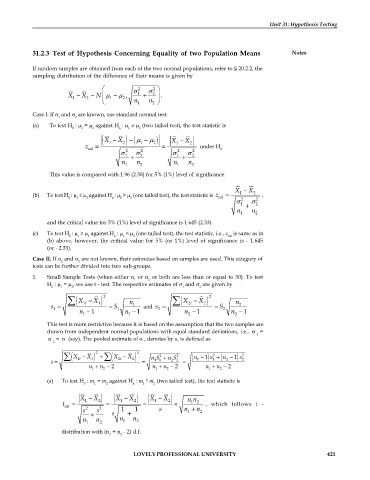Page 429 - DMTH404_STATISTICS
P. 429
Unit 31: Hypothesis Testing
31.2.3 Test of Hypothesis Concerning Equality of two Population Means Notes
If random samples are obtained from each of the two normal populations, refer to § 20.2.2, the
sampling distribution of the difference of their means is given by
æ s 2 s 2 ö
X - X 2 ~ N - 2 , 1 + 2 . ÷
ç
1
1
è n 1 n 2 ø
Case I. If s and s are known, use standard normal test.
1 2
(a) To test H : = against H : (two tailed test), the test statistic is
0 1 2 a 1 2
(X - X 2 ) (- 1 - 2 ) X - X 2
1
1
z cal = = under H .
0
s 1 2 + s 2 2 s 1 2 + s 2 2
n n n n
1 2 1 2
This value is compared with 1.96 (2.58) for 5% (1%) level of significance.
X - X 2
1
(b) To test H : £ against H : > (one tailed test), the test statistic is z = ,
0 1 2 a 1 2 cal 2 2
s 1 + s 2
n n
1 2
and the critical value for 5% (1%) level of significance is 1.645 (2.33).
(c) To test H : ³ against H : < (one tailed test), the test statistic, i.e., z is same as in
0 1 2 a 1 2 cal
(b) above, however, the critical value for 5% (or 1%) level of significance is - 1.645
(or - 2.33).
Case II. If s and s are not known, their estimates based on samples are used. This category of
1 2
tests can be further divided into two sub-groups.
1. Small Sample Tests (when either n or n or both are less than or equal to 30). To test
1 2
H : = , we use t - test. The respective estimates of s and s are given by
0 1 2 1 2
å (X - X 1 ) 2 n å (X - X 2 ) 2 n
2i
1i
s = = S 1 and s = = S 2
1 1 2 2
n - 1 n - 1 n - 1 n - 1
1 1 2 2
This test is more restrictive because it is based on the assumption that the two samples are
drawn from independent normal populations with equal standard deviations, i.e., s =
1
s = s (say). The pooled estimate of s , denotes by s, is defined as
2
2 2 2 2
å (X - X 1 ) + å (X - X 2 ) n S + n S 2 ( 1 1 s + ( 2 1 s
2
n -
n -
1i
2i
) 2
) 1
s = = 1 1 2 2 =
n + n - 2 n + n - 2 n + n - 2
2
2
2
1
1
1
(a) To test H : m = m against H : m ¹ m (two tailed test), the test statistic is
0 1 2 a 1 2
X - X 2 X - X 2 X - X 2 n n
1
1
1
t cal = = = ´ 1 2 , which follows t -
s 2 s 2 1 1 s n + n 2
1
+ s +
n 1 n 2 n 1 n 2
distribution with (n + n - 2) d.f.
1 2
LOVELY PROFESSIONAL UNIVERSITY 421

